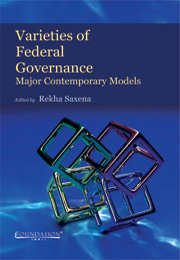Book contents
- Frontmatter
- Contents
- List of Contributors
- Foreword
- Acknowledgements
- Introduction
- I Theoretical and Comparative Dimensions
- II Presidential Federal Systems
- III Commonwealth Parliamentary Federations
- 8 Constitutional Normalization in Canada: The Significance of Failure of the Charlottetown Agreement
- 9 The Australian Senate: Form, Function and Effectiveness
- 10 Federalizing India's Political Parties: National All-India and National Interstate Parties
- 11 Malaysia: Centralized Federalism in an Electoral One-Party State
- 12 Promises Unmet: Multi-level Government in South Africa
- IV Non-Commonwealth Parliamentary Federations in Afro-Asia
- V European Parliamentary Federations
- VI Devolutionary Systems
- VII Supranational Confederalism/Federalism?
10 - Federalizing India's Political Parties: National All-India and National Interstate Parties
from III - Commonwealth Parliamentary Federations
Published online by Cambridge University Press: 05 June 2012
- Frontmatter
- Contents
- List of Contributors
- Foreword
- Acknowledgements
- Introduction
- I Theoretical and Comparative Dimensions
- II Presidential Federal Systems
- III Commonwealth Parliamentary Federations
- 8 Constitutional Normalization in Canada: The Significance of Failure of the Charlottetown Agreement
- 9 The Australian Senate: Form, Function and Effectiveness
- 10 Federalizing India's Political Parties: National All-India and National Interstate Parties
- 11 Malaysia: Centralized Federalism in an Electoral One-Party State
- 12 Promises Unmet: Multi-level Government in South Africa
- IV Non-Commonwealth Parliamentary Federations in Afro-Asia
- V European Parliamentary Federations
- VI Devolutionary Systems
- VII Supranational Confederalism/Federalism?
Summary
Introduction
India has always had numerous political parties. The first election of 1952 was contested by 14 National parties and 60 State parties. (In 1989, 8 National Parties and 20 State Parties). In those days the numbers did not matter, the INC was the dominant majority party.
In the 2004 election there were over 200 parties. By then no single party had enjoyed a majority since the early 1990s. Governments were now in the hands of coalitions, the National Democratic Alliance or NDA (1999–2004) and the United Progressive Alliance or UPA (2004-present). In each coalition there were over a dozen parties, led by either the BJP (the NDA) or the Indian National Congress (INC) (the UPA). Because of their minority status, both leading parties were constrained by their partners.
The Congress party after 2004 was in a weaker position than the BJP in 1999–2004. Whereas the National Democratic Alliance controlled a majority of seats in Parliament, the United Progressive Alliance did not. It was dependent on Left parties that were outside both coalitions.
If the trend away from the two largest parties, classified as ‘National Parties’ continues, government will become even more dependent on so-called ‘State Parties’ nearly all of which are confined to a particular region. India's politics could come to resemble the unstable regime of the French Third Republic.
The watchdog over all the political parties is the Election Commission of India (ECI), which also classifies the parties.
- Type
- Chapter
- Information
- Varieties of Federal GovernanceMajor Contemporary Models, pp. 175 - 207Publisher: Foundation BooksPrint publication year: 2011



